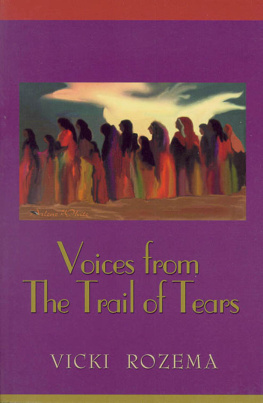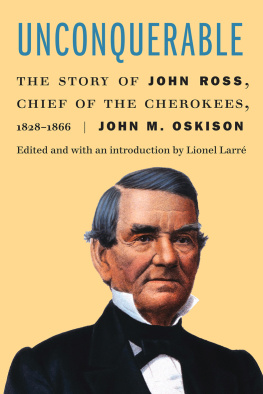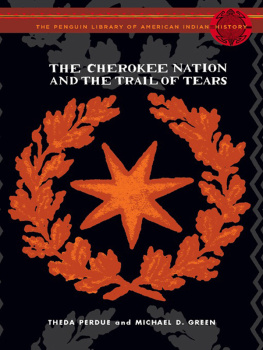After the Trail of Tears
1993 The University of North Carolina Press
All rights reserved
Manufactured in the United States of America
The paper in this book meets the guidelines for permanence and durability of the Committee on Production Guidelines for Book Longevity of the Council on Library Resources.
The publisher wishes to express its gratitude to Walter H. Conser, Jr., for his generous editorial assistance following the death of William G. McLoughlin.
The publication of this work was made possible in part through a grant from the Division of Research Programs of the National Endowment for the Humanities, an independent federal agency whose mission is to award grants to support education, scholarship, media programming, libraries, and museums, in order to bring the results of cultural activities to a broad, general public.
Library of Congress
Cataloging-in-Publication Data
McLoughlin, William Gerald.
After the Trail of Tears : the Cherokees struggle for sovereignty, 18391880/
William G. McLoughlin.
p. cm.
Includes bibliographical references and index.
ISBN 0-8078-2111-x (cloth : alk. paper)
ISBN 0-8078-4433-0 (pbk.: alk. paper)
I. Cherokee IndiansHistory19th century. 2. Cherokee Removal, 1838. 3. Cherokee IndiansPolitics and government. 4. Cherokee Indians.Government relations. I. Title.
E99.C5M388 1993
973.04975dc20 93-18532
CIP
cloth 05 04 03 02 01 7 6 5 4 3
paper 07 06 05 04 03 9 8 7 6 5
This book is gratefully dedicated to Virginia, Helen, Gail, and MarthaTo tell you that youre wonderful, Too wonderful for words.
Contents
Maps
1 Trail of Tears, 18381839
2 Cherokee Lands in the West
3 Park Hill
4 Indian Territory
5 Cherokee Nation, 1889
6 Indian Territory, 1889
7 Land Openings, 18891906
Introduction
Whereas, it being the anxious desire of the Government of the United States to secure the Cherokee nation of Indians a permanent home, and which shall, under the most solemn guarantees of the United States, be and remain theirs forevera home that shall never, in all future time, be embarrassed by having extended around it lines, or placed over it the jurisdiction of any of the limits of any existing Territory or States the parties hereto do hereby conclude the following Articles.
Treaty of 1828
In 1831 the U.S. Supreme Court, led by Chief Justice John Marshall, defined the Cherokees as a domestic, dependent nation. The Cherokees put the emphasis on nation; the Bureau of Indian Affairs put the emphasis on dependent. Congress preferred to define Indians as wards of the government. This is a study of how these varying interpretations worked themselves out in the years 183980. However, more was at stake than legal definitions.
The United States went through a major reorientation in race relations during the first administration of Andrew Jackson. Historians have generally agreed that the rise of the Cotton Kingdom, the nullification crisis, and the launching of William Lloyd Garrisons abolition movement in the years 1828 to 1832 led the way to the sectionalism of the Civil War and the consequent emancipation of the slaves. As George Fredrickson, a preeminent historian of racism, has noted, the apparently paradoxical fact that the abolitionists could thus gain support for their attack on slavery at the very time a newly systemized doctrine of black inferiority was also triumphing in American thought deserves attention.Indians so that it could be settled by white pioneers was his first goal as president.
However, beyond this lies another paradox. By 1830 the southeastern tribes (Cherokees, Creeks, Choctaws, Chickasaws, and Seminoles), who held millions of acres of land in the Cotton Belt, were known as the most civilized tribes in America and had adopted the agricultural system of their white neighbors, including the institution of black chattel slavery. Yet Jackson engineered their removal across the Mississippi on the grounds that they were too savage to compete with whites: Established in the midst of another and a superior race and without appreciating the causes of their inferiority or seeking to control them, they must necessarily yield to the force of circumstances and ere long disappear.
To assess the impact of racism on the Cherokee Nation, this book examines the role of slavery in Cherokee culture after removal and the crisis it brought to the Cherokees in 1861 when they were forced to decide whether to take part in the white mans Civil War. Central to that issue, and to all of the questions facing Native Americans in the years 1830 to 1887, was the deep-seated question of Indian sovereignty. Were the 300 or so Indian nations with whom the United States dealt through treaties (and whom the various missionary societies classified under foreign missions) sovereign, or were they simply ethnic enclaves subject to the same assimilation process as foreign-born immigrants? If they were not assimilable, then must they be relegated to reservations to eke out their few remaining years until, like the buffalo, they became extinct? They could hardly be treated like the unassimilable Chinese and Japanese, who were prevented from entering the United States. Paradoxically, although white Americans (whether they were Indian reformers or Indian haters) concluded after 1865 that the Indian race could not succeed in competition against the Aryan or Teutonic races, Indians were told that they must give up their primitive, non-American method of owning tribal land in common and become homesteaders; that is, they must be de-tribalized and become American citizens. Few expected them to survive for long, but it was considered their only chance; survival of the fittest races was as divinely ordained as survival of the fittest farmers or businesspeople.
By 1830 most Native Americans were well aware that deeply ingrained prejudice would reduce them to second-class citizens if they ever gave up their status as independent nations. The Cherokees had adopted a constitution modeled on that of the United States in 1827 and, in effect, declared their independence from any ties to the United States, except for those mutually agreed upon in treaty obligations. Other tribes also insisted on their independence, arguing that while treaties required their diplomatic alliance with the
The tactics and arguments used by the Cherokees in the nineteenth century are still drawn upon by Native Americans presently struggling for sovereigntya word that does not mean simply self-government or autonomy but something of far deeper cultural significance, in some respects equivalent to ethnic and political separatism. In her 1988 book Sovereignty and Symbol, a study of recent Mohawk conflicts in New York State, Gail H. Landsman quotes a Mohawk spokesperson who says in 1988, We shall resist by every means any aggression, any violation of the treaties, any disturbance of our people in the free use and enjoyment of our land, any usurpation of our sovereignty, and encroachment and oppression.
The forty years after the Trail of Tears constitute an all-but-forgotten era in Cherokee history. Historians have focused after 1839 upon the Indians of the Great Plains, whose heroic defense of their homelands in the last of the Indian wars distracted attention from the equallyif not moresignificant struggle of the southeastern nations to retain their sovereignty by diplomacy in Washington, D.C. Between 1839 and 1880, the Cherokees, having lost 4,000 of their 18,000 people on the Trail of Tears, rebuilt their homes and farms, roads and bridges, mills and shops, in the northeast corner of the Indian Territory (present-day Oklahoma). They reinstituted their bicameral legislature and judicial system (modeled on that of the United States but retaining crucial aspects of their traditions) and inaugurated their own public school system to replace that of the missionaries (which the United States subsidized prior to 1830). They survived a serious guerrilla campaign from 1839 to 1846 involving those whom they held responsible for the false treaty that enabled Jackson to remove them. By the 1850s their nation was thriving once again, a showcase for foreign visitors of the progress that Indians could make in civilization and Christianization.






